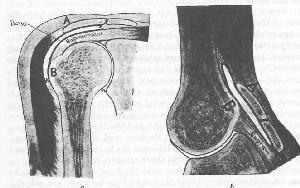File:Codman 162 - small.jpg
Codman_162_-_small.jpg (300 × 188 pixels, file size: 21 KB, MIME type: image/jpeg)
Figure 17. Elevation of scapula-humeral joint. Coronal sections of right shoulder in anatomic position and in elevation. These two figures were made for me by Mr. Aitkin in 1908, and have been used as lantern slides on many occasions since. The fact that I publish them again, after twenty-five years of further study of this region, indicates my belief in their essential accuracy. Although drawn from frozen sections they are confessedly semi-diagrammatic. Notice the deltoid and its origin from the edge of the acromion. Notice the subdeltoid or subacromial bursa with its roof made by the under surface of the acromion and by the fascia beneath the upper portion of the deltoid. Its base is on the greater tuberosity and on the tendon of the supraspinatus, which separates it like an inter-articular fibrocartilage from the true joint. b illustrates the condition which would be found in elevation, the tuberosity having passed under the acromion and the point B having passed the point A. It is obvious that the convex floor of the bursa, as it lies on the tendon of the supraspinatus and on the tuberosity, should have a smooth, even, rounded surface. As a matter of fact, the first time one cuts into a normal bursa one is startled to find how much the base looks like the joint itself One cannot distinguish by sight the line between the portions which are on bone or on tendon beneath the shiny base. It is obvious that if the surfaces of the bursa between the points A and B in a were adherent, it would be impossible for the joint to pass into the position shown in b.
Note for the reader who likes puzzles. Notice in Figure b the changes that the axes of the letters A and B have undergone in relation to the bottom of the page. Each letter has rotated twice. The letter A has rotated upward 45 degrees by elevation of the clavicle, but since the clavicle has rotated backward, the artist has had to rotate the vertical axis of the letter in order to make it legible. The letter B has twice rotated, each time in an opposite direction. Once because the artist rotated it on the humerus and once by elevation of the humerus itself. You may not understand this now, but after you have read the next chapter and have mastered Figs. 30 and 31, return to this puzzle and agree with me, only to disagree again, for the B has been inverting as it rotates and should be upside down and right, side out, like the contour of the articular surface.
File history
Click on a date/time to view the file as it appeared at that time.
| Date/Time | Thumbnail | Dimensions | User | Comment | |
|---|---|---|---|---|---|
| current | 21:24, 27 March 2020 |  | 300 × 188 (21 KB) | Alexandre.laedermann (talk | contribs) |
- You cannot overwrite this file.
File usage
The following 2 pages uses this file:
